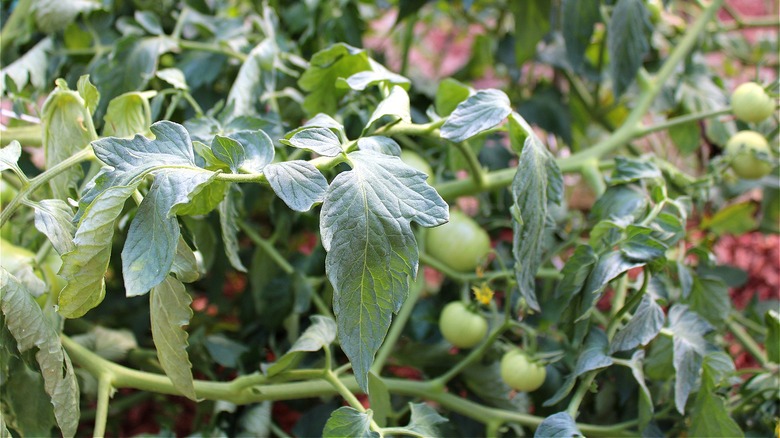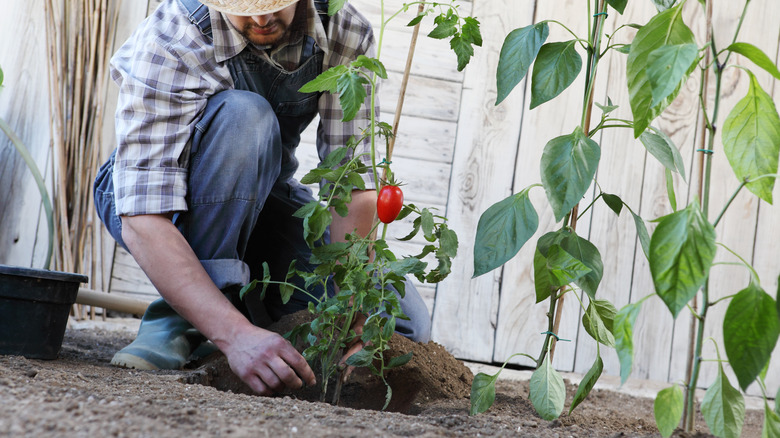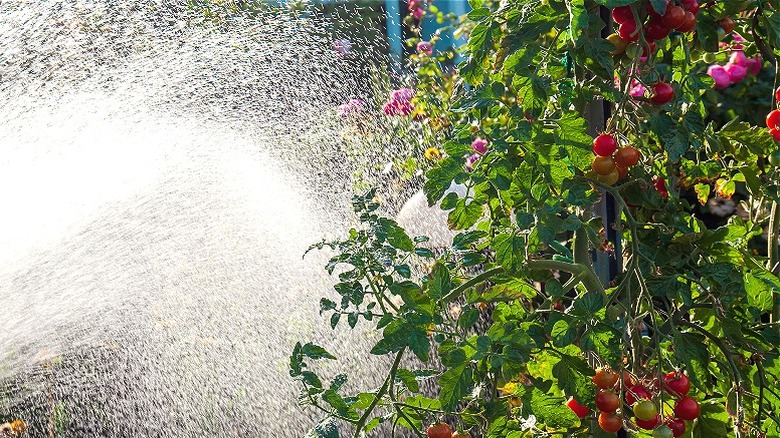The Best Way To Rescue An Overwatered Tomato Plant
All you wanted was to grow the best tomatoes in your garden so you could show the world the true meaning of "tomato girl summer." After all, the viral social media trend should rightfully be reserved for home gardeners rather than style-obsessed fashionistas, right? Only problem is your tomatoes are far from the red, ripe, juicy versions fueling the seasonal fruit's fresh vibe. Instead, you're dealing with wilted leaves and bumps on the base of the plant — common signs of overwatering. Fortunately, tomato plants are incredibly resilient and can easily be rescued from excess hydration by simply allowing their roots and soil to dry out.
Saving a tomato plant isn't complicated, provided you land on the correct diagnosis. With tomato plants, this can be tricky given that symptoms of overwatering often mimic those of underwatering. For example, drooping leaves can be a sign your tomato plant is thirsty, but it can also signal that you're irrigating too much, too often. To identify the real problem, use a garden trowel or your finger to test the moisture level of the soil at the base of your tomato plant. If you dig down a couple of inches and the soil is bone-dry, the problem is dehydration. Conversely, if the soil is soggy, you've got an overwatering issue. If the latter is the case, act fast to avoid root rot. The fungal infection inhibits the plant's ability to absorb water and nutrients and can lead to death if left untreated.
Dry out roots and soil
The best way to save an overwatered tomato plant is to stop watering it. Try this simple technique first, especially if the base of the plant is surrounded by standing water and the leaves are only slightly wilted. If you catch overhydration early, there's a good chance you can rescue your tomato plant just by pausing watering until the soil dries out.
Rescuing potted tomato plants from excessive watering requires a bit more effort. Start by carefully removing the plant from the pot, making sure not to damage the roots. Next, gently shake off any damp soil before placing the plant on a stack of newspapers. Let it sit for at least a few hours so the excess water has time to drain and be absorbed by the papers. Meanwhile, thoroughly inspect the tomato plant's roots. If you notice they're dark brown, black, slimy, rotted, or contain mold, snip off the affected areas with a sharp pair of garden shears. Then, dump out all of the original soil from the container and replace with fresh, dry mix before repotting the plant.
The same process can fix overwatered tomato plants growing in your garden. However, replant in a dry location that's deep enough for the tomato plant's roots to spread out. One of the mistakes everyone makes when planting tomatoes is overcrowding. Keep plants 18-24 inches apart in the same row and wait a few days before watering to allow the roots to thoroughly dry.
Ways to prevent overwatering
An ounce of prevention is worth a pound of cure — and then some — when it comes to saving tomato plants from overwatering. You can avoid excessive irrigation by being strategic regarding when and how much water to give your tomato plants. For starters, aim to water in the morning to reduce evaporation, but don't overdo it. Tomato plants need 1 to 2 inches of water per week if planted in your garden, while mature potted varieties need 1 gallon a day. In addition, pots should feature multiple drainage holes, which should be monitored for proper flow during your daily watering routine, as faulty drainage can lead to oversaturation.
Also, keep an eye on weather conditions. Recording rainfall amounts will help you avoid overwatering. Likewise, consider tracking how much sunlight your tomato plant is exposed to each day. Ideally, tomato plants should receive 6 to 8 hours of sun per day to avoid overwatering. Without adequate light, the soil will not dry out properly between watering, which can lead to boggy conditions that accelerate root rot.
Finally, if you're worried that implementing conservative watering methods will solve the issue of oversaturation, but possibly lead to dehydration, consider adding an even layer of organic mulch — shredded leaves, straw, and grass clippings — around your tomato plants. Doing so will conserve moisture and control weeds that rob tomato plants of water and vital nutrients.


